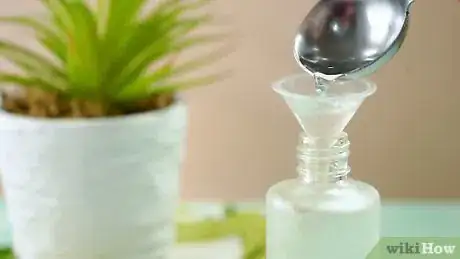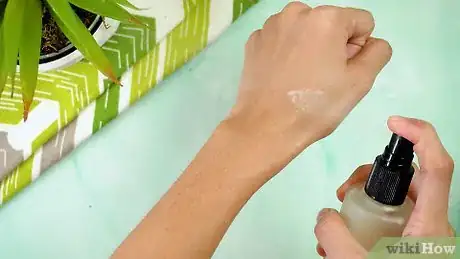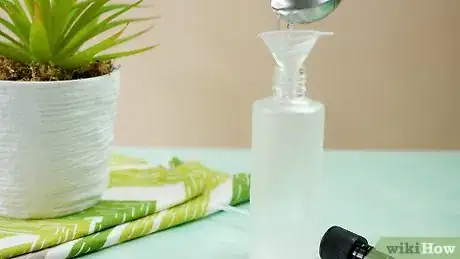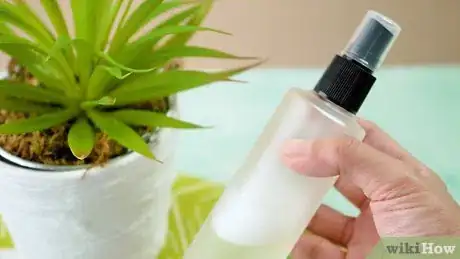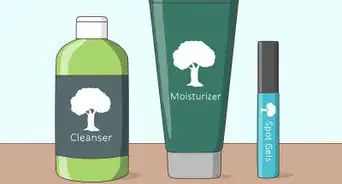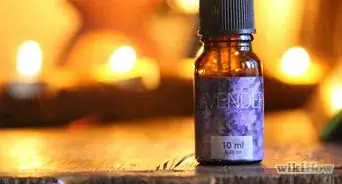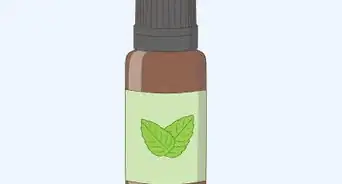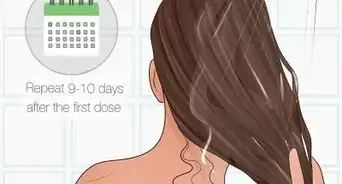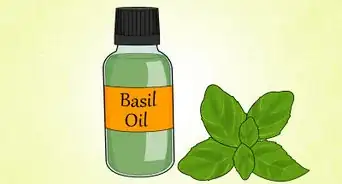This article was co-authored by wikiHow staff writer, Jessica Gibson. Jessica Gibson is a Writer and Editor who's been with wikiHow since 2014. After completing a year of art studies at the Emily Carr University in Vancouver, she graduated from Columbia College with a BA in History. Jessica also completed an MA in History from The University of Oregon in 2013.
There are 8 references cited in this article, which can be found at the bottom of the page.
The wikiHow Video Team also followed the article's instructions and verified that they work.
This article has been viewed 35,968 times.
Learn more...
Lemongrass essential oil is a popular scent for homemade sprays. Its grassy, citrusy flavor combines well with other essential oils, making it effective for insect repellent or room spray. Shake the lemongrass essential oil with other insect-repelling oils before going out in mosquito-infested areas. You can also make a room spray with refreshing lemongrass, spearmint, grapefruit, and rosemary essential oils. Spritz it in the air on or linen to neutralize odors.
Ingredients
- 20 drops of lavender essential oil
- 20 drops of tea tree essential oil
- 20 drops of citronella essential oil
- 15 drops of lemongrass essential oil
- 5 drops of geranium essential oil
- 1 teaspoon (4.9 ml) of neem oil
- 1 tablespoon (15 ml) of vodka or denatured alcohol
- 4 tablespoons (59 ml) of distilled water
Makes a 3 fl oz (89 ml) bottle of spray
- 2 tablespoons (30 ml) of witch hazel
- 2 tablespoons (30 ml) of distilled water
- 5 drops of lemongrass essential oil
- 10 drops of spearmint essential oil
- 10 drops of grapefruit essential oil
- 5 drops of rosemary essential oil
Makes a 2 fl oz (59 ml) bottle of spray
Steps
Making Insect Repellant with Lemongrass
-
1Pour neem oil, vodka, and distilled water into a bottle. Set a small funnel on a 3 fl oz (89 ml) spray bottle and pour in 1 teaspoon (4.9 ml) of neem oil. Add 1 tablespoon (15 ml) of vodka or denatured alcohol and 4 tablespoons (59 ml) of distilled water.[1]
- It's important to use distilled water instead of tap water to prevent the spray from spoiling.
- If you don't like the strong scent of neem oil, you can leave it out. However, if you're specifically trying to repel mosquitos, consider adding it.
-
2Add lemongrass, lavender, tea tree, citronella, and geranium essential oils. Citronella and tea tree essential oils may have strong scents, but they're great at keeping insects away. Pair them with lemongrass, lavender, and geranium essential oils, which smell wonderful and can repel flies, mosquitos, and fleas. Put these oils into your bottle:[2]
- 20 drops of lavender essential oil
- 20 drops of tea tree essential oil
- 20 drops of citronella essential oil
- 15 drops of lemongrass essential oil
- 5 drops of geranium essential oil
Advertisement -
3Screw the lid on the bottle and shake the spray for 10 seconds. Put the lid on the bottle and screw it on tightly so the bottle is completely sealed. Shake the spray for at least 10 seconds to help the oils combine with the vodka and water.[3]
- Spray the repellent before each use since the oils will separate as the spray is stored.
-
4Spray the lemongrass mixture on your skin before going outside. If you know you'll be going outside in insect or mosquito-infested areas, spritz your skin thoroughly. You might need to reapply the repellent if you'll be outside all day.[4]
- Store the repellent at room temperature for up to 3 years. Although you could keep using the spray, the oils will become less effective the longer they're stored.
Tip: Keep this lemongrass insect repellent out of children's reach. If they ingest the spray, call poison control immediately.
Mixing Lemongrass Room or Linen Spray
-
1Pour witch hazel and distilled water into a 2 fl oz (59 ml) spray bottle. Set a small funnel on your bottle and slowly pour in 2 tablespoons (30 ml) of witch hazel along with 2 tablespoons (30 ml) of distilled water.[5]
- If you don't have witch hazel, use vodka. Either of these help release the essential oils when you use the spray.
-
2Add lemongrass, spearmint, grapefruit, and rosemary essential oils. Put all of your essential oils into the small bottle. If you'd like to make an all-lemongrass spray, use only 30 drops of lemongrass essential oil. For a refreshing lemongrass room spray, add all of these to your bottle:[6]
- 5 drops of lemongrass essential oil
- 10 drops of spearmint essential oil
- 10 drops of grapefruit essential oil
- 5 drops of rosemary essential oil
-
3Close the bottle and shake the mixture for 10 seconds. Put the screw cap tightly on the bottle so the bottle is completely sealed. Then, shake the bottle to combine the witch hazel, water, and essential oils.[7]
- Shake the bottle before each use since the oils and water will separate a little.
-
4Spritz the lemongrass spray around your home or on linen. To remove unpleasant smells or to just make your room smell better, spray the mixture around the room. Keep spraying until you can smell the lemongrass. If you're ironing linen, spray the surface of the fabric with the mixture until it's wet. Then, iron the linen to remove wrinkles.[8]
- You can also spray your pillow or sheets before bed to enjoy a calming scent as you fall asleep.
-
5Use the lemongrass spray within 3 years. Store the spray at room temperature and shake it gently before using it. Since the essential oils will become rancid over time, discard the spray after 3 years or if it develops an unpleasant odor.[9]
Tip: Remember to label the outside of the bottle so you know what type of spray you made. Include the date so you know how long to store the spray.
Warnings
- Avoid using essential oil products around young children, because their skin and respiratory systems are more sensitive to them.[10]⧼thumbs_response⧽
Things You'll Need
Making Insect Repellant with Lemongrass
- Measuring spoons
- Small funnel
- 3 fl oz (89 ml) spray bottle
Mixing Lemongrass Room or Linen Spray
- Measuring spoons
- Small funnel
- 2 fl oz (59 ml) spray bottle
References
- ↑ https://youtu.be/ssfMExDCL04?t=22
- ↑ https://youtu.be/ssfMExDCL04?t=6
- ↑ https://youtu.be/ssfMExDCL04?t=31
- ↑ https://thethingswellmake.com/essential-oils-mosquitos-homemade-repellent-spray-recipe/
- ↑ https://www.crazyinspiredlife.com/diy-essential-oil-aroma-spray/
- ↑ https://www.crazyinspiredlife.com/diy-essential-oil-aroma-spray/
- ↑ https://www.crazyinspiredlife.com/diy-essential-oil-aroma-spray/
- ↑ https://www.spiritedwellbeing.com/non-toxic-room-spray/
- ↑ https://www.usingeossafely.com/shelf-life-of-essential-oils-and-how-to-make-them-last-longer/
